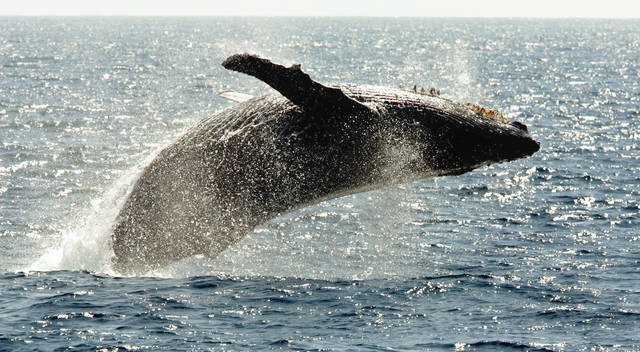LIHUE — Hawaii is seeing fewer humpback whales during the December through May season when the marine mammals migrate from their Alaskan fishing grounds to winter in warmer waters.
And this week, researchers are convening to compare clues, swap monitoring methods and form a consensus on what to do moving forward.
On Kauai, numbers recorded in the annual Hawaiian Islands Humpback Whale National Marine Sanctuary’s whale counts have dipped to less than half what they were in 2014, keeping in rhythm with statewide trends.
The 2018 season on Kauai kicked off early, with one of the first sightings reported Oct. 18 from a Blue Dolphin Adventures tour.
Researchers first started noticing a decline in December 2015, when shore-based observers started recording a decline in sightings of whales in general and specifically of mother-calf pairs.
But, that doesn’t necessarily mean that the oceanic mammoths are dying off, or that they’re still not migrating to the islands.
In fact, scientists say it’s too early to draw conclusions about the phenomenon and that more research is necessary.
That’s why a consortium of whale experts will be meeting today and Wednesday in Honolulu to better understand the decrease in sightings.
Marc Lammers, research coordinator for the agency’s Hawaiian Islands Humpback Whale National Marine Sanctuary, said different research groups have collected various data sets that all seem to point toward decreased whale sightings.
“People started to report fewer sightings and there was concern about what might be going on,” Lammers said in a telephone interview. “We’ve noticed that there’s been basically a decrease in the overall acoustic energy levels that we’re picking up produced by humpback whale songs.”
But there are many variables that are not yet fully understood, he said. The whales could have reached their environment’s capacity and the decrease could be a natural plateauing effect, or the humpbacks could be simply going to different areas that aren’t as closely monitored, such as the uninhabited Northwestern Hawaiian Islands.
“We just know that we’re not seeing them in the same places that we’re expecting to see them,” he said. “Part of the key to their success and recovery is they tend to be quite adaptable. They follow a certain pattern but then they have variation from that pattern.”
In March 2015, Kauai and the Big Island averaged two whales every 15 minutes, and Oahu averaged three every 15 minutes.
March 2014 yielded an average of three whales every 15 minutes on Kauai and Oahu, and two per every 15-minute time period on the Big Island.
Kauai reported four whale sightings every 15 minutes in March 2013, and Hawaii and Oahu calculated an average of three.
Many theories are being considered, including the possibility that warmer ocean temperatures are reducing food supplies in the north, said California State University, Channel Islands’ Rachel Cartwright, lead researcher at the Keiki Kohola Project. If the female whales are not getting enough food, they would be unable to ovulate and reproduce, she said.
Cartwright has published data about the decline and plans to present new data at this week’s meetings.
The data her group has gathered focuses on mother and calf pairs and shows a drop of nearly 80 percent in sightings from 2014 to 2018. That is consistent with what Lammers and others have found, and could help explain the lack of whale songs heard in Hawaiian waters.
“There is a substantial decline in the number of whales we’re seeing. But when we look very closely at least in the waters off Lahaina (Maui), which is where most of the whales congregate, that decline is very much accounted for by the drop in the number of mother and calf pairs,” Cartwright said. If there are fewer females, the males who sing have no reason to stick around, she said.
Cartwright said she doesn’t believe the whales are in danger of becoming massively depleted again, but thinks it’s important to understand the connection between environmental and climate changes in Alaska and the whales’ behavior.
Researchers and scientists are tackling the phenomenon from all angles, enlisting new technologies along the way and trying to figure out the pattern.
The Pacific Islands Fisheries Science Center in Honolulu, for instance is partnering with Google’s Artificial Intelligence arm to use machine learning techniques to identify whale songs, for instance.
National Oceanic and Atmospheric Administration researcher Ann Allen is behind that project and hopes the partnership will help analyze more than 170,000 man hours-worth of data.
That could help researchers decide if the reduction in sightings is just the whales changing course, maybe migrating further north through the Northwestern Hawaiian Islands.
That and many other theories are going to be aired out at the meeting of the minds in Honolulu this week.
“Historically there are high years and low years and there are natural kind of ebbs and flows with the population number that’s completely normal,” said Stephanie Stack, chief biologist with the Pacific Whale Foundation. “But a steady downward trend is not a good sign.”
•••
Jessica Else, environment reporter, can be reached at 245-0452 or jelse@thegardenisland.com. The Associated Press contributed to this report.


